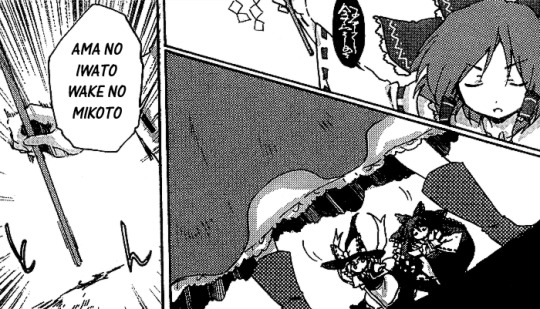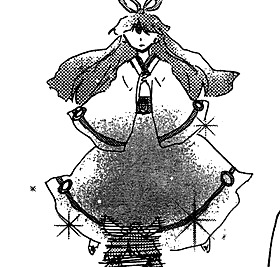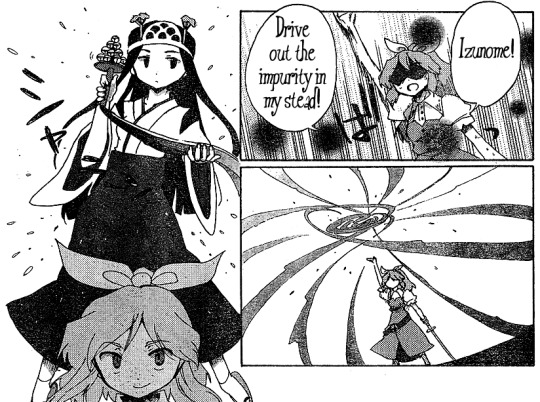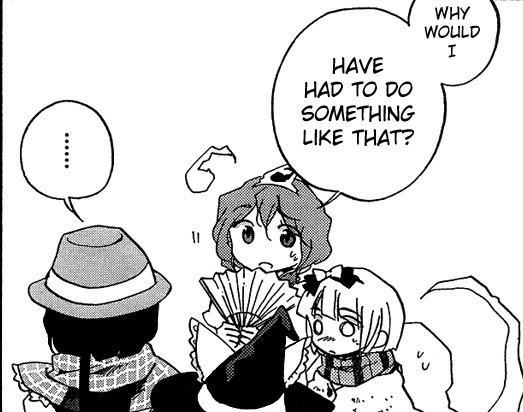#source: ssib
Note
If you don't mind, can you explain exactly what a shikigami is in touhou?

From what we can gather, the shikigami is essentially a program inhabiting the body (1) (possibly "spiritual form", since Ran became a shikigami out of the Animal Realm (2), whose residents don't have physical bodies) of another youkai, erasing the original personality completely or semi-completely (3) (if the program is implemented successfully, that is). However, the original memories of the body seem to initially remain, per Ran's route of UDoALG... though hers seem to be fading. Poor thing (4).
In that sense, Ran has already started to forget that she is a shikigami (5) (artificial program implemented on top of the actual fox's mind). Chen, meanwhile, is buggy, and regularly alternates between her programming and her original personality (6); Ran evidently kind of just copy/pasted, being as she is an uncreative AI. As for Zenki and Goki, on the other end of the spectrum, their bodies are noted to move robotically and jerkily in SSiB (7); evidently getting a personality in there was less important to Yukari than disposable servants that did the tasks she wanted them to.
Ran in particular is limited by her programming such that she cannot act in ways that she does not think explicitly fall within the scope of her orders (8) (when she's functioning properly, that is). Because Chen is buggy, sometimes she, on the other hand, runs off on her own to care for the cats at Mayohiga and such.
I haven't included any of Yukari's testimony on exactly what shikigami are, because she's an obviously biased party. But other sources confirm it pretty well.
(1):

(2):

(3):

(4):

(5):

(6):

(7):

(8):

38 notes
·
View notes
Text
Every god with a cameo appearence in SSiB
After much deliberation, here it is. The lore post promised long ago. The translator notes for SSiB focus on locations of famous shrines of the mentioned deities and include a few mistakes, so I figured it’s worth writing a short introduction to each of the gods summoned or otherwise mentioned in this manga.
The gods are arranged by chapter of first appearence; due to length and number of images, the list has been placed under a read more. Please do not take this warning lightly.
Chapter 1

Ama-no-iwato-wake no kami - one of the gods partaking in the “descent of the heavenly grandson” alongside Omoikane (whose Touhou counterpart is Eirin). Doesn't actually seem to be too prominent, sources available in English mention that he's a deity of gates (but not the only one and seemingly less versatile than a few other kami he shars this title with), and some Kojiki commentaries consider him an epiteth of Ame-no-Tajikarao, yet another participant of the descent, known for his prodigious strength, and for cooperating with Omoikane once before already – when Amaterasu refused to leave the cave Ama-no-iwato (which I assume is where the epiteth theory comes from). Based on Kanako’s comments from LoLK, it’s possible he’s a Lunarian in Touhou, like all the other Kojiki celestial gods.

“Lord Daikoku and his 180 children” - or rather Okuninushi, the ruler of Izumo and leader of the earthly gods in Kojiki. He's viewed as the gongen of the god of luck Daikoku, as both are gods of agriculture. All around nice guy, sometimes portrayed as unusually tall and strong, and hero of many myths, including these of white hare of Inaba and the god Sukuna-Hikona (both of whom are portrayed as his advisers from time to time; the scarecrow god Kuebiko plays this role in th Kojiki too).
Chapter 2

Chang'e needs no introduction, I think. Unlike almost everyone else here, she's not a Shinto deity.
Chapter 5

Sumiyoshi sanjin/daijin – the trio of Sokotsutsu no O no Mikoto, Nakatsutsu no O no Mikoto and Uwatsutsu no O no Mikoto. As the manga itself explains, they're the gods of sailing and safe voyage. They're brothers of the Watatsumi, who are, depending on the version, either three gods of the sea... or a single god, Ryujin, also known as Owatatsumi, who rules the seas from his Dragon Palace (and whose daughters the Watatsukis are based on). Curiously it seems they're also star gods, which certainly fits well with their role in SSiB plot (the stars they correspond to are the same ones Remilia names the rocket modules after, too). They're also associated with empress Jingu as she purportedly asked for their help before embarking on a military expedition against Korea.
Chapter 12

Gion – the former Gion shrine is known as Yasaka shrine today (no relation to Yasakatome). The enshrined deity is Susano-o, invoked to ward off disease. In the past he was often conflated with Gozu Tenno (who in turn was conflated with Matara-jin, but let's not go down this rabbit hole today), the most significant of the “epidemic gods” who acted as both sources of disease, presented as punishment in this context, and as saviors bestowing fast recovery and good health on the faithful. Like many similar shrines it was also involved in rituals meant to purify a certain class of restless spirits to make them act as deities protecting from diseases.
Chapter 13

Atago – the god of mount Atago, originally worshiped by Shugendo monks. He's a gongen (manifestation) of an aspect of Jizou, specifically “Shogun Jizou”, a tutelary deity of soldiers... and firemen (the idea is that Jizou can transfer injuries and suffering to himself). He is occasionally conflated with Kagutsuchi, the kami of fire killed right after being born (worth nothing Keiki's mythical counterpart is his sister). Other, more popular version, makes him a tengu who repented and became a protector of the pious human inhabitants of Mt. Atago; a variant of this legend claims said tengu was the true form of Nichira, a buddhist mentor of prince Shotoku (there's a Matara-jin connection here, as well, but let's save that for another day...)
Chapter 14

Honoikazuchi - one of the eight thunder gods created from pieces of Izanami's dead body in Yomi. They chase after Izanagi when his visit plan goes south, assisted by mysterious “hags of Yomi” (there are sources which claim the hags and thunder gods from this myth are what oni are based on in folklore, but such fanciful claims were only made by the “national learning” movement, which was seeking a way to purify culture from buddhist influences, and as such lack merit).

Kanayamhiko - a kami of metal, a tutelary deity of blacksmiths, miners, coalmakers, and so on (also, yet another sibling of Keiki's mythical counterpart, also “born” in the myth of Kagutsuchi). I assume he's summoned to change daggers into sand because early on in Japanese history save for some imported crafts all the iron was the result of a lengthy process relying on iron sand rather than ore. As a side note – most shrines related to blacksmith work enshrine a female deity named Kanayako, who's functionally identical to the Kanayamahiko from Nihon Shoki. Both historians and religious authorities appear to believe the gender of the deity was flipped at some point for unknown reasons. He had a slightly bigger cameo in WaHH.
Chapter 15

Amatsu Mikaboshi - an enigmatic earthly god mentioned in the Nihon Shoki – a god of stars (which explains why he's invoked to deal with Marisa's spellcards). He resisted the land transfer and was severly punished for it. Many online sources portray him as some sort of “primordial evil,” which is a misunderstanding, perhaps originally caused by a peculiar string of events (though more likely by ignorance) – first Mikaboshi with conflated with Myoken (the pole star; guess which obscure figure referenced in Touhou which won't be discussed here was Myoken associated with?), then, during the Meiji reforms, Myoken was rejected due to being a syncretic deity, and many Myoken temples were converted into temples dedicated to Amenominakanushi, one of the only gods explicitly predating Izanagi and Izanami in the creation myth (seemingly there were no shrines dedicated to him prior to the dawn of the “national learning” movement, though). “Primordial evil” Mikaboshi portrayals, which cut the middleman (eg. Myoken), extrapolate the heavenly gods calling him an evil deity into him being a god of evil.

Ishikori-dome – a tutelary kami of mirror-makers. Yet another associate of Omoikane, both in the myth about luring Amaterasu out of a cave, and then during the descent of the heavenly grandson. According to the myths she's responsible for creating the Yata no Kagami, one of the imperial regalia. Following the LoLK logic (“Lunarians are like the celestial gods,” eg. The Kojiki gods who descended from the heavens and subjugated the earthly ones) she might be a Lunarian.
Chapter 16

Ame no Uzume – a kami of dawn and dance. She too is an associate of Omoikane, partaking in getting Amaterasu out of a cave (which her SSiB appearence echoes) and in subujgation of the earthly gods during the descent of the heavenly grandson (she marries Sarutahiko, one of the rulers of the earthly gods – seemingly of a different group of them than the Izumo gods following Okuninushi). As above, probably should count as a Lunarian in Touhou.

Amaterasu – does she need an introduction? The central deity of Shinto, the ruler of them all, the sun, the progenitor of the imperial family. Simply put, a god too significant to show up in Touhou for longer than two panels. She's basically here as an extension of Ame no Uzume's myth.
Chapter 17

Oomagatsumi – ritual impurity given form, one of the two basically identical kami created while Izanagi was undergoing ritual ablutions after returning from Yomi, the land of the dead.
Chapter 18

Izunome – as far as I can tell, making her a shrine maiden is ZUN's own invention. In the Kojiki, she's born when Izanagi purifies himself after escaping the land of the dead, and that’s quite literally where her role both starts and ends. She seemingly has no shrines today, though Japanese wikipedia mentions an Amaterasu shrine which in the past held some festival related to “Izunome-jin”. I'm pretty sure she's here because she and Oomagatsumi are part of a single myth, and represent a specific instance of pollution and its immediate removal.
Chapter 19

Takeminakata – that's just Kanako. LoLK confirmed it, if anyone still had any doubts by then. There are dozens of versions of the myth, it honestly deserves its own post, so I won't discuss that here.
61 notes
·
View notes
Note
Is Kanako Okina's daughter? When Yukari gets captured in SSiB, she suggests that Kanako is Takeminakata, the son of Ōkuninushi, which seems to be basically Okina. The japanese community never talked about this, so I can't help but wonder if it's just wrong or something went wrong with the translation.
First of all you should not ask me any questions about Matarajin because I know basically nothing about Matarajin.
Second of all, while I am willing to believe that Matarajin is conflated with literally everyone and everything in Japanese mythology/history, I think a huge amount of your argument is being obscured by your casual “Okuninushi is basically Okina” which probably requires a little more elaboration than that. So even if this connection can be made, it’s not necessarily as straightforward or obvious as you’re assuming. Actually you seem to have it backwards in that you’re kind of acting as if Kanako being Takeminakata requires an explicit “suggestion” from one specific source while Okina being Okuninushi is just obvious. When I feel like it’s probably the other way around?
Then again, as I said I don’t know anything about Matarajin. Hopefully someone else can read this and elaborate further because this kind of question really isn’t in my ballpark.
6 notes
·
View notes
Text
Blue gentle at evening will increase the consumption of sweets in rats
http://tinyurl.com/y4gft9jt
A brand new research demonstrates that only one hour of publicity to blue gentle at evening – the sort of gentle produced by the screens of our many gadgets – raises blood sugar ranges and will increase sugar consumption in male rats. This research, led by Anayanci Masís-Vargas and colleagues from the College of Strasbourg and College of Amsterdam, was introduced this week on the annual convention of the Society for the Research of Ingestive Conduct (SSIB) in Utrecht, Netherlands. Earlier analysis has proven a powerful correlation between weight problems and the degrees of synthetic gentle at evening. A lot of the bogus gentle we are actually uncovered to comes from LED lights and LED screens, which emit excessive ranges of blue gentle. Retinal cells of the attention are delicate to this blue gentle and straight convey info to areas of the mind that regulate urge for food Of their research, Masís-Vargas and colleagues, uncovered rats to nighttime blue gentle and measured their meals consumption and glucose tolerance the next day. It needs to be famous that, with the intention to higher mannequin human gentle publicity, the rats used on this research have been diurnal, that means awake in the course of the day and asleep at evening, fairly than the standard nocturnal laboratory rats that are awake throughout nighttime hours. The authors discovered that after just one hour of nocturnal blue gentle publicity, glucose tolerance was altered in male rats, a warning signal of pre-diabetes. To analyze what occurs with urge for food management and meals selection after publicity to blue gentle at evening, the rats got the choice to decide on amongst a nutritionally balanced meals (normal rodent meals), water, lard, and sugar water. After the publicity to blue gentle, they noticed that the male animals drank extra sugar that evening than in the course of the nights with no blue gentle publicity. These research present clearly that being uncovered to gentle, particularly blue gentle, at evening is disruptive and that display use at evening might improve our tendency to snack on sugary meals and disrupt our means to course of that sugar, particularly in males. Although the rats have been examined after just one evening of sunshine publicity, over time, this might result in weight achieve and the event of diabetes. “Limiting the period of time that we spend in entrance of screens at evening is, for now, the perfect measure to guard ourselves from the dangerous results of blue gentle. In case it’s essential to be uncovered to gadgets at evening, I’d suggest using apps and evening mode options on the gadgets, which flip the screens extra orange and fewer blue or using blue gentle filtering googles which can be already obtainable available in the market.” Masís-Vargas says. ### Analysis quotation: Acute publicity to blue gentle at evening impairs glucose tolerance, alters insulin secretion and improve sugar consumption in a diurnal rodent. Anayanci Masís-Vargas,2,3, David Hicks1, Andries Kalsbeek2,3, Jorge Mendoza1 1Light, Imaginative and prescient and the Mind Workforce, Institute de Neurosciences Cellulaires et Intégratives Strasbourg, France, 2Hypothalamic Integration Mechanisms, Netherlands Institute of Neuroscience Amsterdam, Netherlands, 3Department of Endocrinology and Metabolism, Amsterdam UMC Amsterdam, Netherlands Offered July 2019, Society for the Research of Ingestive Conduct, Utrecht, Netherlands Contact: Jorge Mendoza, PhD [email protected] +33 03 88 45 66 96 Disclaimer: AAAS and EurekAlert! are usually not accountable for the accuracy of stories releases posted to EurekAlert! by contributing establishments or for using any info via the EurekAlert system. Source link
0 notes
Text
Outcomes Following Hypofractionated Dose-Escalation using a Simultaneous Integrated Boost Technique for Treatment of Spine Metastases Not Amenable to Stereotactic Radiosurgery
Publication date: Available online 29 October 2018
Source: Practical Radiation Oncology
Author(s): Ahsan Farooqi, Andrew J. Bishop, Saphal Narang, Pamela K. Allen, Jing Li, Mary Frances McAleer, Claudio E. Tatsui, Laurence Rhines, Behrang Amini, Xin A. Wang, Amol J. Ghia
Purpose
Spine stereotactic radiosurgery (SSRS) delivers an ablative dose of radiation (RT) with high conformity relative to standard fractionated RT. This technique is suboptimal for extended targets (>3 vertebral levels) owing to treatment alignment concerns, or for patients with marked epidural extension. In these patients, we hypothesized that use of hypofractionated IMRT/VMAT to dose escalate the GTV to 40 Gy as a spinal simultaneous integrated boost (SSIB) would allow for durable local control and palliation.
Methods and Materials
We retrospectively analyzed 15 separate spinal sites (12 patients) treated using the SSIB technique from 2012-2016. The GTV and CTV were prescribed 40 Gy and 30 Gy, respectively, in 10 fractions. The spinal cord was allowed a maximum point dose of 34 Gy. The GTV was defined as gross tumor. The CTV encompassed the GTV, in addition to the involved vertebral bodies, at risk paraspinal space and spinal canal, followed by a PTV expansion of 3-5 mm.
Results
The median follow-up for patients in our cohort was 17 months. At 1 year, local control was 93%, and overall survival was 58%, with a median time to death following treatment of 7 months. There were no grade 2 or higher neurological toxicities reported for any of the patients. 9 of 12 patients had pain at presentation, of which 7 (78%) reported improvement and/or complete resolution of their pain following treatment.
Conclusions
Our early experience using a dose of 40 Gy to the GTV delivered via a SSIB technique, in lieu of SSRS yet more aggressive than conventional palliative doses, provides durable local control and pain relief. This technique may allow for improved local control and palliation in patients with radioresistant disease, when compared to conventional 3D-conformal fractionated RT (3D-CRT).
https://ift.tt/2Oei1Yz
0 notes
Text

Brilliant
925 notes
·
View notes
Note
What are the most important properties of a Marisa?


















you can’t make me choose
32 notes
·
View notes
Text

SSiB making marisa almost as tall as yuyuko and a nearly a head taller than youmu feels incorrect
51 notes
·
View notes
Text



god, SSiB’s party outfits are so freaking good
27 notes
·
View notes
Text

the okuu plural read does not come from nowhere
17 notes
·
View notes
Text

Glad Marisa and I on on the same page about "black-textbox Reimu"
42 notes
·
View notes
Text

What the fuck is this panel?
39 notes
·
View notes
Note
Does Gensokyo extend infinitely up and down?
The most relevant source on this question is WaHH chapter 25 where they mention that back in SSiB they managed to travel all the way to the moon without passing through the barrier. IE: the Hakurei Barrier does, in some sense, go all the way up.
However, that doesn’t mean Gensokyo does. At some point they left Gensokyo and moved to the Lunar Capital, all without passing through a barrier of any kind. In other words, the Lunar Capital is on the same side of the barrier as Gensokyo. But they are not the same place.
Likewise, it seems like it’s possible for Reimu and Marisa to travel to Hell just by sort of flying there in WBaWC. While it’s not explicitly stated it’s kind of inferred that Hell is under the Earth in some sense. In Japanese the word for Hell literally means “earth prison.” Also you can reach Heaven just by flying from the top of Youkai Mountain in SWR.
Meanwhile, it’s impossible to reach the Outside World simply by traveling, instead the scenery will start to loop (again, from WaHH 25).
Anyway, the point I’m making is that while the barrier might extend infinitely up and down, at some point you will leave the place known as Gensokyo and end up in a different world.
14 notes
·
View notes
Note
There's this inconsistency from GoU that I can't see the way out of, how would you make sense of it? Sagume shown up publicly, and also publicly announced that a youkai came to her delivering a letter from Eirin. But in SSiB it was mentioned that there are lunar spies on earth, communicating with Eirin is a crime, and the moon can detect and aggressively defend against sources of kegare (which youkai are). And why would Eirin willing to listen to Yukari and call Sagume over this minor incident?
Sagume personally visited Eirin fairly recently in AFiEU. Plus the Watatsuki sisters in Inaba. As for Eirin, it is of course in her best interest to remain in contact with high ranking Lunarian officials, most of whom seem to deeply respect her even though she's officially a fugitive.
Basically you seem to be underestimating how corrupt the Lunar Captial really is. Not in any metaphysical sense involving kegare or whatnot, but in a very human, political sense. A crime is only a crime if those in charge want to enforce it. When it's their own crimes, or they personally benefit from it, those enforcers have no motivation to act.
Eirin has restablished her connections to people in power, so she's essentially above the law. Who do you think is in charge of those spies you mentioned? It's gotta be someone like Sagume, right? The black ops squad Eagle Rabbit were reporting to her, weren't they? Who's in charge of the lunar emissaries which would be the ones arresting her? The Watatsukis.
This corruption goes all the way to the top.
IE: There's a really good reason for the Lunar Capital to fear Eirin coming back and leading a coup. She could succeed.
15 notes
·
View notes

